| The 2019 Dennis Wheatley Convention |
The twelfth Dennis Wheatley Convention was held at The Manor in Elstree on Saturday 26th October. The Manor was the set for some of the scenes in the 1968 film of ‘The Devil Rides Out’, and has been the home for our Convention for all our Conventions to date.
In a break with tradition, we ate out on the Friday night – at a Turkish restaurant in Edgware recommended by Declan; Izgara in Station Road. It was a good choice on a variety of counts – it gave the Convention a slightly different ‘feel’, which was good, and both the venue and the food and drink were absolutely first rate. Thank you, Declan !
Saturday morning saw us assembled in the Arkley Room, and even though a number of familiar faces were absent because of other commitments, we had a decent number. It is strange how often the number thirteen crops up at these events !
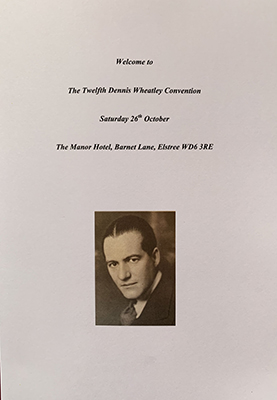 |
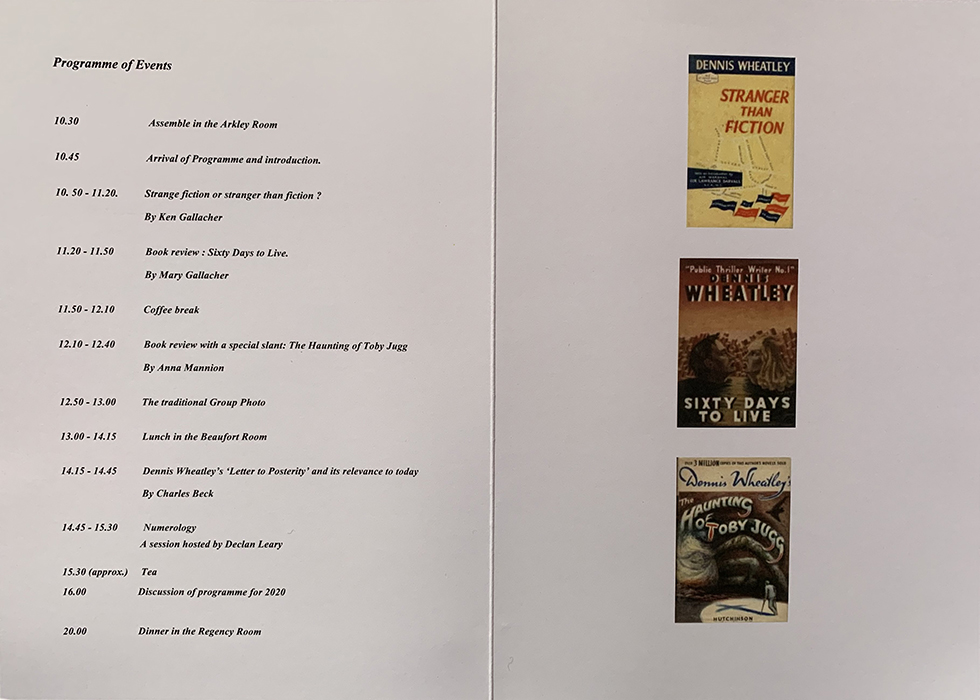 |
|
DW’s briefcase is cheekily impersonated by Ken’s picnic hamper (above), and (below) the commemorative programme |
|
I would like to say that I brought in the Convention programmes in Dennis Wheatley’s briefcase as tradition dictates, but unfortunately I can’t because for some unaccountable reason I forgot to bring it along. Hubris. Ken G gallantly stepped in with a replacement – a picnic hamper which for some reason he had with him. Did he know I was going to forget the briefcase? Is he clairvoyant? Whether he is or isn’t, it did the job beautifully and looking on the bright side, it was something else to make the Convention different from its predecessors. That said, I will try not to make the same mistake twice!
|
|
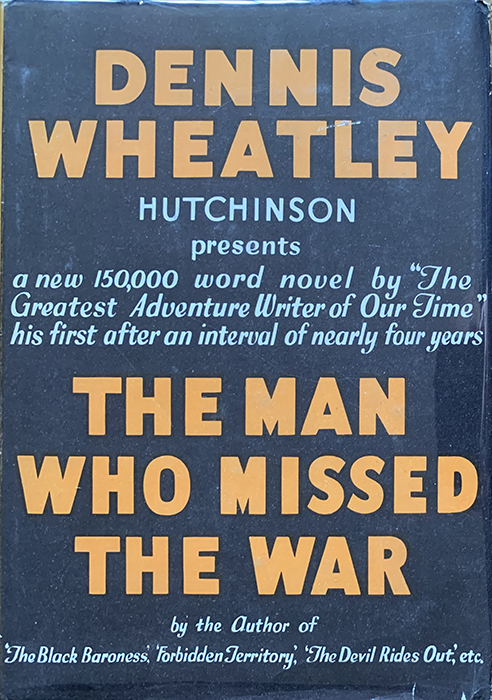
|
|
'Strange fiction or stranger than fiction ?’Ken G talks about ‘The Man Who Missed The War’ A word of caution – if you haven’t yet read the three books reviewed below, you might just want to skip over these reviews until you have read the books because they contain ‘spoilers’ |
|
Ken G opened the day with a study of Dennis Wheatley’s first book to be written after he had finished his stint as a deception planner in World War Two – ‘The Man Who Missed The War’. One of DW’s least know and least appreciated books, Ken had recently re-read it, and gave us his impressions.
In the story, which incorporates a suggestion DW had made to the Joint Planning Staff that wartime supplies for Britain could be ferried across the Atlantic in tug-guided rafts, the hero Philip Vaudell is on just such a raft. Things go wrong and he and his female stow-away companion drift down to the Antarctic.
Ken characterised the first two-thirds of the book as ‘fine’ by DW’s standards, but found that the last third was ‘pretty wacky’, involving as it did Atlanteans living hidden away on Antarctica and using astral projection and other occult means to try to assist Adolf Hitler. Because of this, although the novel is generally classified as a ‘Lost World’ novel, as indeed it currently is by Bloomsbury, it could equally well be classified as a ‘Black Magic’ novel.
The ‘Lost World’ element was definitely a homage to Jules Verne and Edgar Allan Poe, and there were elements of H P Lovecraft too, but what particularly interested Ken was the way in which DW correctly stated that not all of Antarctica was covered by ice. In this he was correct, because although the bulk of the continent is covered in ice, there are dry valleys completely devoid of ice in the area known as McMurdo sound. This feature had been discovered by the late nineteenth / early twentieth century Antarctic explorers, but it was typical of DW that he had done his research, even if he then took liberties with where these valleys were to be found and with some of the other geographical features in the book.
In sum, although it might be one of DW’s ‘wackier’ novels, it should not be completely written off.
Mary followed Ken with a review of ‘Sixty Days to Live’. While ‘The Man Who Missed The War’ was DW’s first book post-war, ‘Sixty Days To Live’ was DW’s last book to be published pre-war. Indeed, DW wrote in his own copy how this, his thirteenth novel, did not initially do well because it was published only a week before war broke out, and its title was not thereafter exactly his public was hoping to see. Nevertheless the book made him money in the fullness of time.
It is generally considered one of DW’s two science fiction books – the other being ‘Star of Ill Omen’, which Darren led us to reappraise with the typically erudite article which he contributed to last year’s Convention.
Mary had chosen ‘Sixty Days To Live’ to review because it was out-of-series, and because she considered the descriptions of the female characters were particularly good and realistic.
Interestingly, not only had the book had a favourable written review from Steve Patton a few years ago, but a straw poll revealed it to be quite a favourite with Mary’s audience on the day, so as always she had chosen her topic well.
The two principle female characters are the lead, Lavinia Leigh, a twenty three year old starlet and her sister Margery, who is in her shadow. Lavinia is self-assured and manipulative, and Mary considered the interplay between her and her sister as the story unfolded had been written skilfully and perceptively.
The plot, in broad terms, is that Lavinia’s uncle, who works at the Greenwich Observatory, leaks to the family that a comet is racing towards Earth, and when it hits there will be a global catastrophe of epic proportions.
The family build an ark – which Mary reproduced in a stunningly beautiful drawing – and there are some starkly realistic (perhaps) scenes depicting how people behave (not well) in light of their impending doom. This, and how people would behave if civilisation was ending, was a topic of deep interest to DW, and one he had also dealt with in his third-ever-published and very different novel ‘Black August’.
Without giving too much away, Mary found not only the characters but the overall theme of how one would react to total forthcoming disaster both absorbing and well written, and many of us made notes that we ought to read (or re-read) the novel at an early opportunity.
As Ken G had mentioned on a previous occasion, whenever he pictured Lavinia, he thought of the American actress Myrna Loy, and who knows – maybe DW was doing the same when writing. But if he was, as far as we know, and perhaps wisely, he didn’t admit it – at least in public !
After a coffee break, Anna gave a book review and analysis of one of DW’s best-loved novels, ‘The Haunting of Toby Jugg’, considered by many to be among his very finest occult novels, and one of the few DW wrote in the first person
While discussing the whole novel, Anna made special reference to the female characters, because after the hero (Toby) and his main antagonist (Helmuth), all the principal characters are women.
Before running through the plot and the characters, Anna commented on the unusual (and not just for DW) construct of the novel; being written as it is not only in the first person, but also for the most part in the form of the hero’s day-by-day written journal. That DW was able to pen an entire book in this fashion (a few of his others are written in the first person, but none as journals) and have it then rank as one of the very best examples of its genre, was a real testament to his considerable writing skills, which are often overlooked when people talk of his ‘ability to tell a good story’.
The female characters of note are two women who nurse Toby, who was a fighter pilot shot down by a German fighter in World War Two, and who is now bed-ridden (one woman replaces the other, and the different depictions are interesting), crazy Great Aunt Sarah, who plays a pivotal role at the climax of the story, and Toby’s legal guardian’s wife, Julia.
Julia. How I wish I could reproduce the way Anna said the name, in the way that Toby might have done, in the manner of a love-struck teenager who had never really met a woman. It was absolutely classic and showed us that Declan is not the only member of our group with a gift for mimicry. ‘Joooooolia’ is the closest I can get to it in writing.
Anyway, right from the beginning Toby is yearning to see his beloved Julia again, and if Freud had been on tap he would have written a book about it; but then Julia (who only makes her first physical appearance quite some way into the book, on page 214; again evidencing particularly skilful writing) is not all that Toby thinks she is, and he has rather misread her. Hence the book being written by DW rather than Freud.
All-in-all, Anna gave a fascinating analysis, and if she didn’t quite put the writer of this piece off women for a lifetime, she certainly confirmed his dislike of spiders.
Anna’s talk was followed by the traditional ‘Group Photo’ which appears at the top of this report, and that was followed by lunch in the Regency Room.
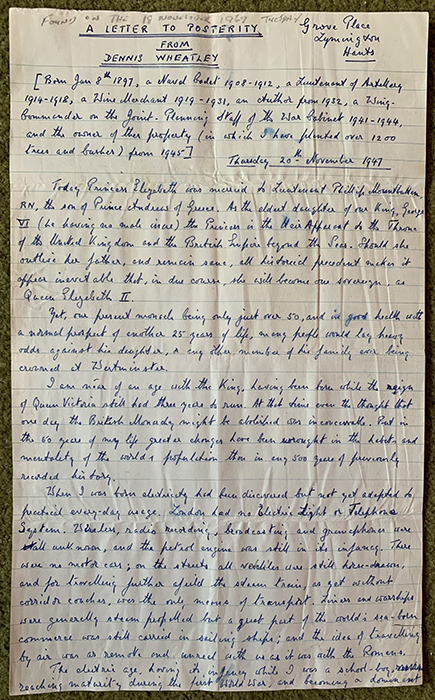
|
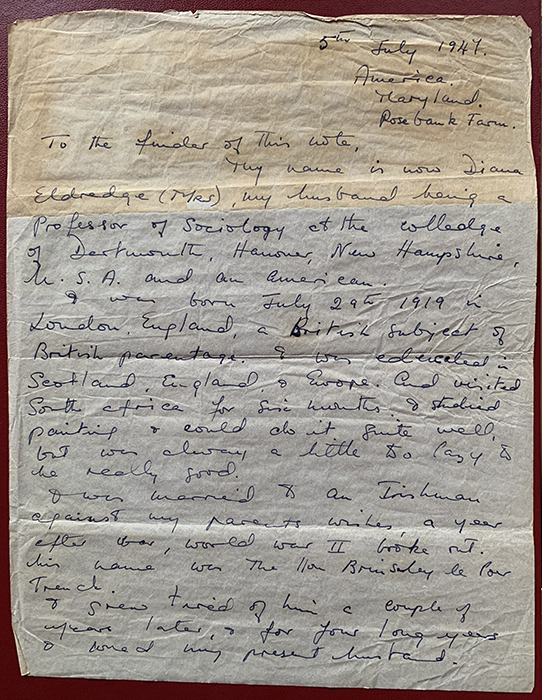
|
|
Charles discusses Dennis Wheatley’s ‘Letter to Posterity’, and its relevance to today |
|
After lunch it was Charles’s turn, and we moved moving from discussion fiction to discussing fact; but fact of a kind so unusual that if we read it in a DW novel we would probably take it for one of his less-believable storylines. Indeed, as Charles prefaced his short talk by remaking, it was worth pausing to reflect on the deeply unusual nature of the document – DW’s famous ‘Letter to Posterity’.
As the group knew, DW had written the letter (and a pencil draft which survives in Leeds University’s Special Collections archives) on 20th November 1947, the day when the future Queen Elizabeth II married the future Prince Philip. He then inserted the letter into a bottle along with a shorter letter by DW’s step-daughter Diana, and buried in an urn on his terrace.
DW’s intention was that it would be found and read in the distant future when the country might have become a socialist / communist state in which there was no freedom and in which personal advancement was entirely in the gift of a party apparatus, and that his letter might inspire a suitable audience to rebel and – at whatever cost – restore the concept of individual liberty. He was presumably assuming that anyone who opened a bottle on the Grove Place Estate (he could have had no inkling that his house would be demolished in his lifetime) would be the sort of person who would read it with interest rather than a Commissar who would promptly burn it.
Passing round revised transcripts of DW’s letter and Diana’s rather childlike accompanying note, Charles picked out the key concerns that were in DW’s mind when he set pen to paper and discussed the extent to which DW’s fears had been overblown hyperbole, and how in some areas he had actually been quite prescient in raising issues.
One such area was the way in which new communications technologies were being developed which would bombard people with too much information, and how this might allow the unscrupulous to disseminate simplistic remedies for complicated problems, which people might uncritically take-on verbatim.
It may be that with all the current talk about Twitter and the like and ‘Fake News’, the modern generation will think that here, if nowhere else, DW was making a valid point.
Moving from the more serious to the more light-hearted, in the session that followed, the ever jocular Declan hosted a quiz with a numerological theme.
Numerology, it will be recalled, is a system whereby names can be reduced to numbers, and thereby reveal the planet which most influences a person’s spiritual nature.
To see how DW described it in ‘The Devil Rides Out’, where he first introduced the concept, click here.
Declan’s quiz – just played for fun, and not in teams – went through three rounds and featured questions such as ‘Which member of the Convention shares a number with Napoleon?’, ‘Which member of our Convention shares a number with the Duke and Simon Aron?’, and ‘DW, Mocata, Marie Lou and Tanith all share the same number, as do three of our Convention. Can you guess which ones?’
You can work out the answers if you like.
After cups of tea and coffee, we settled down to discuss what we wanted to do in 2020, for our thirteenth year, in a discussion hosted by Ken G.
You can see the group’s unanimous conclusion on the Conventions and Field Trips page of the website. To go to it, click here.
After the discussion, the group sessions finished and everyone had a chance to catch up with what their friends had been doing since they had last seen them, or to have a look at Mary’s ever growth ‘wall of Convention events’
The Travelling Museum
They also has a further opportunity to look at this year’s ‘Travelling Museum’, the theme of which was DW’s first book ‘The Forbidden Territory’, with items on display including a signed jacketed first edition, the promotional postcard, the menu for the launch party held on Tuesday 3rd January 1933, a photograph of DW with Sir Lionel Earle and the Belgian Ambassador, Baron de Cartier de Marchienne and the Baron's letter of thanks for his invitation to the event, plus the booklet for ‘Crossing The Forbidden Territory’, the game that was played by DW’s friends at his home a couple of evenings later as the celebrations continued, with copies of the book as prizes, plus a couple of other odds and ends.
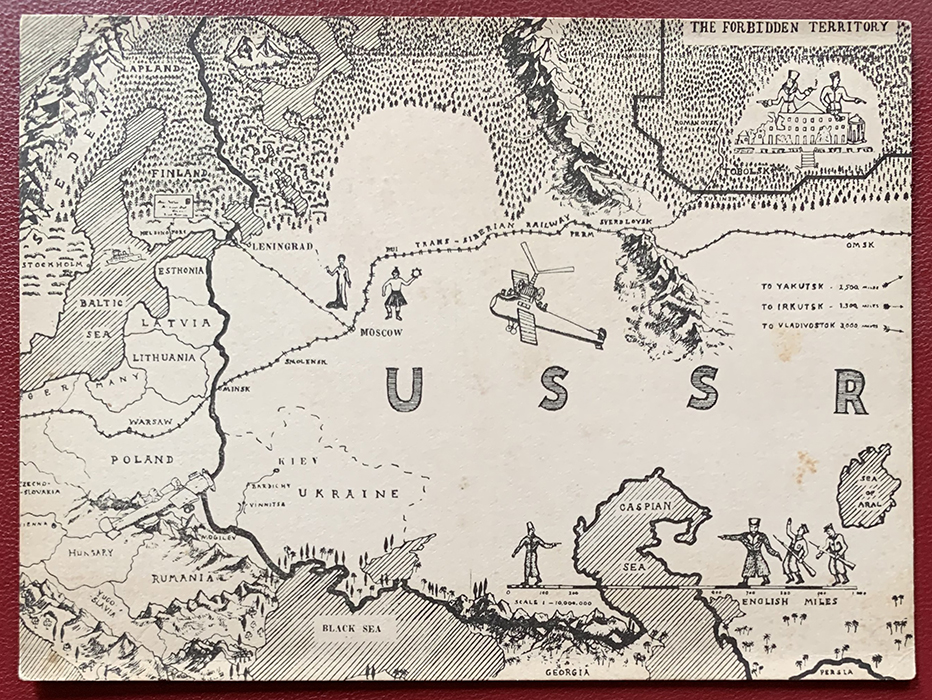 |
 |
||
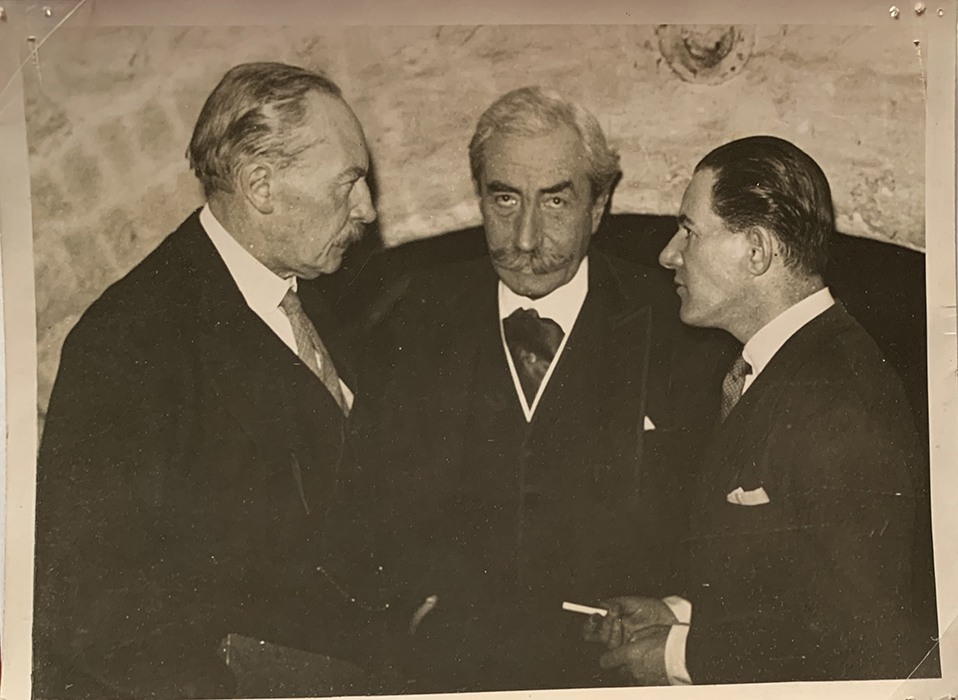 |
 |
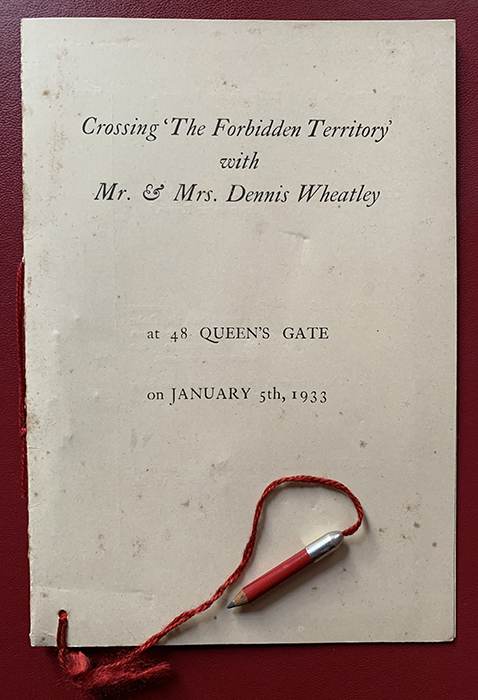 |
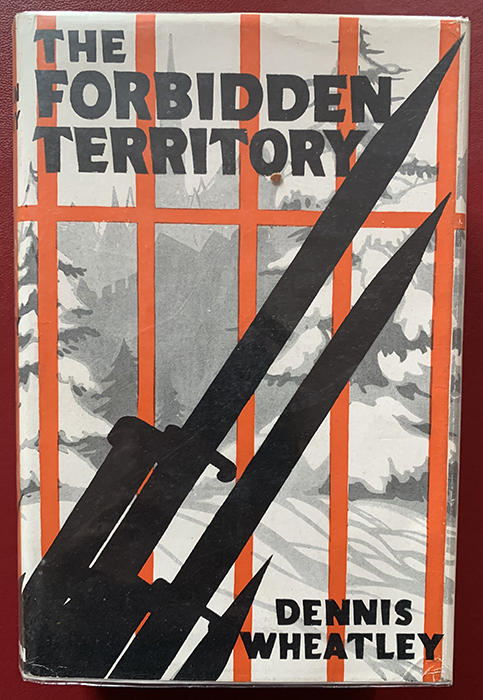 |
Drinks at the bar followed, and then dinner was served in the Regency Room, as tradition demands.
 |
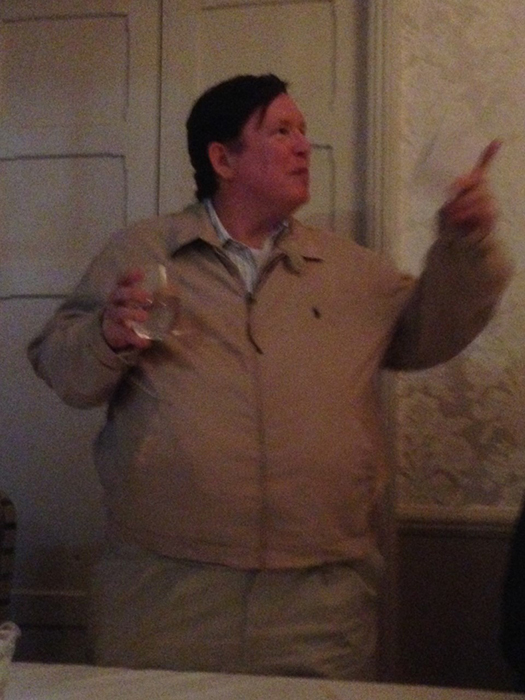 |
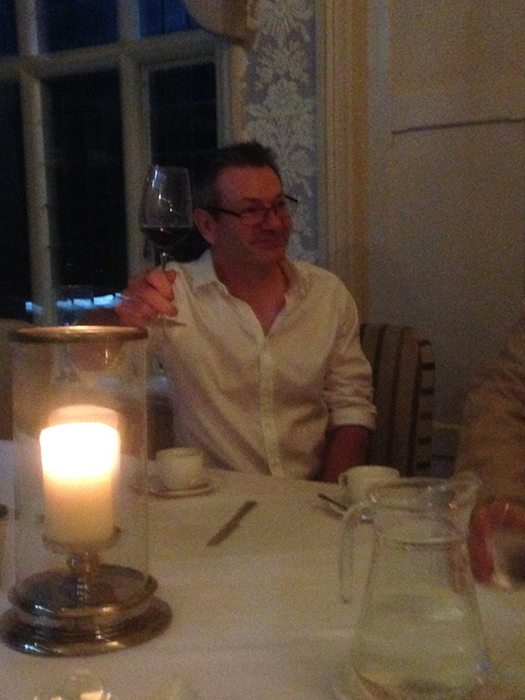 |
Dinner in the Regency Room
As always, the dinner was a jolly and memorable occasion. Towards the end of the meal, Mark led the toast to absent friends followed by Franklin who led the toast to DW. To conclude the toasts, Ken G proposed the toast to ourselves, to which all drank heartily.
Those who had the stamina carried on into the night, but your reviewer went upstairs and to sleep dreams predicting an equally good Field Trip / Convention next year. I am sure it will turn out to have been what DW and Joan Grant would have termed a ‘true dream’.
C.T.H.B.
 |
 |
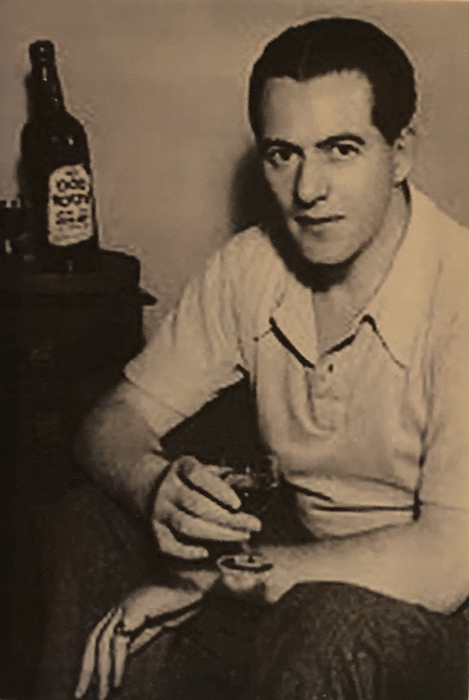 |
This page last updated Copyright © 2002-2006 Bob Rothwell. 2007-2025 Charles Beck.